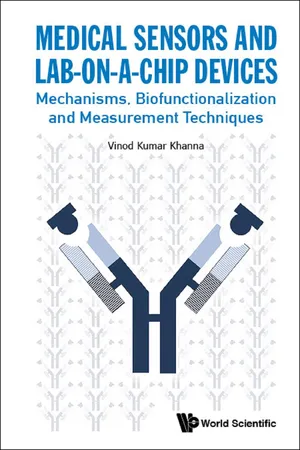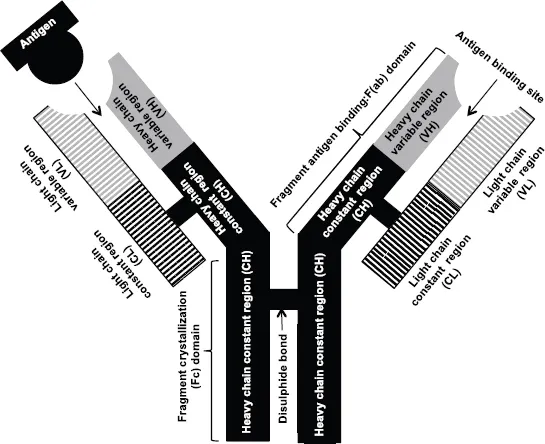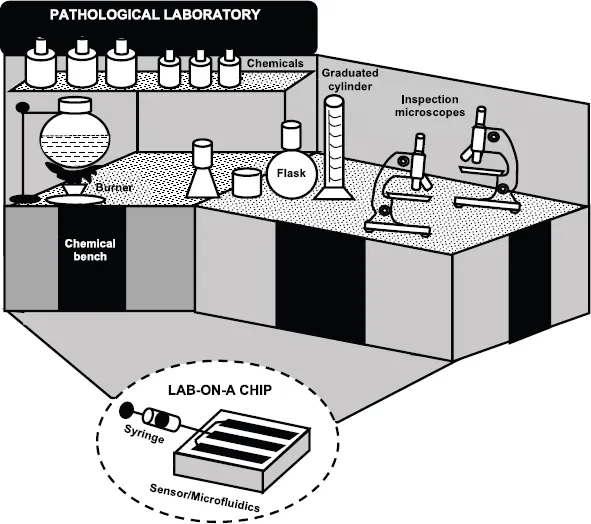![]()
Chapter 1
Emerging Trends in Medical Diagnostic Devices
1.1Introduction
In this chapter, two new types of medical diagnostic devices are introduced which have the potential to revolutionize disease detection by greatly simplifying the investigative procedures in the near future. They cater to the immediate global needs for affordable healthcare of premium quality accessible to a larger segment of human population.
1.2Medical Sensors
The word ‘medical’ is an adjective. It means ‘of or pertaining to the science or practice of medicine’. Medicine is a noun referring to the science and art dealing with the maintenance of health. It is primarily concerned with the prevention, alleviation, or cure of disease. The disease is a disorder either in the structure or function of a living organism leading to loss of ‘easy’ state; hence called dis-ease or disease.
A sensor is a device that detects changes in environmental conditions by responding to a physical, chemical or biological stimulus such as heat, light, sound, pressure, magnetism or a mechanical motion; presence of a particular chemical species, change in composition of a substance or concentration of an ion; a biomolecule such as a nucleic acid, antibody/antigen [Shnayder et al., 2005]. The output signal from the sensor is converted into a readable display at the measurement site or transmitted over a network to a remote location for further processing. Looking around, one finds sensors in almost every electronic application. Sensors are becoming more common and are being applied in more applications. Medical sensors are the sensors used in various ways for detecting diseases and in the equipment developed for curing them. They constitute only a small subgroup of the vast family of electronic sensors used in consumer market and industrial sector.
A biosensor is an analytical device formed by combining two distinct components: (i) A biological component such as an antibody/antigen, enzyme, organelle or whole cell which is immobilized by covalent or non-covalent bonding or physical entrapment to interact with the analyte thereby imparting specificity to the detection; and (ii) a physico-chemical transducer which serves as the platform on which the biomolecule is immobilized, and transforms the elicited response into an electrical signal, that is subjected to amplification for easy measurement. Figure 1.1 explains the organization of a biosensor.
1.3Antibody and Antigen
A class of biosensors known as immunobiosensors or immunosensors is aimed at the detection of the presence of specific antibodies or antigens. This class of biosensors received special attention for the diagnosis of diseases. These immunosensors are based on antibody–antigen binding. An antibody is a glycoprotein having carbohydrate group attached to the polypeptide chain. It is also called immunoglobulin (abbreviation: Ig). An antigen is an extraneous or foreign substance which when introduced in the body activates its immune system, the natural defense system of the body, to produce an antibody. Antigens can be: (i) Microorganisms, e.g., bacteria, viruses, parasites and fungi. (ii) Allergens like dust, pollen, bee stings, etc.
1.3.1Shape and structure of the antibody
The general shape of an antibody resembles the letter “Y” of English alphabet (Fig. 1.2). Each arm of the letter Y has a binding site. An antigen whose shape matches with that of the binding site gets attached to the antibody. In this way, the antibody binds an antigen whose shape is specifically identical with that of the binding site on the antibody. Then the antigen gets fitted into the antibody. Bodily processes take over, destroy/inactivate the antigen and eliminate the antigen from the body.
Fig. 1.1Diagrammatic representation of a biosensor.
Fig. 1.2Antibody shape and structure.
As shown in Fig. 1.2, in the Y-shaped antibody molecule, there are four polypeptides: (i) Two identical heavy chains or H-chains consisting of a constant region CH and variable region VH. (ii) Two identical light chains or L-chains comprising a constant region CL and a variable region VL. On the basis of small differences in polypeptide sequence, the light chains are categorized as kappa (κ) and lambda (λ) light chains. Five types of Ig heavy chain labeled as α, δ, ε, γ and μ are found in IgA, IgD, IgE, IgG and IgM antibodies, respectively, to be discussed below. The variable regions at the ends of the heavy and light chains contain 110–130 amino acids. The amino acid sequence of variable regions is different for different antibodies imparting them specificity towards particular antigens.
The antibody structure contains two F(ab) domains and one Fc domain. The F(ab) domain binds to the associated antigen. The Fc domain binds to endogenous receptors (i.e., those having internal origin) on the surface of lymphocytes as well as to secondary antibodies. It is also possible to covalently link enzymes and dyes with the Fc region.
1.3.2Classification of antibodies
According to the functions performed by them, based on the number of Y-units and the kind of heavy chain, antibodies are subdivided into five classes called isotopes: (i) IgG: Smallest in size and able to pass through cell membranes, these are most common antibodies in blood/body fluids. (ii) IgA: These are found in the mucus, saliva and tears. Respiratory, digestive, and reproductive tracts too contain these antibodies. (iii) IgM: The largest of the antibody types, it works like IgG but is unable to cross the cell membranes. (iv) IgD: They are present in small quantity on the surfaces of B cells that aid these cells to recognize the antigens. (v) IgE: They are present in serum and produce allergic reactions. An allergen binding with IgE antibody triggers the release of histamine from certain cells known as mast cells. The mast cell is also termed mastocyte or labrocyte: A kind of white blood cell. Histamine is an amine produced in local immune response.
1.4Lab-On-A-Chip Devices
The lab-on-a-chip or a micro total analytical system (μTAS) is a miniaturized chip, a few millimeters across in size, and capable of performing several functions carried out in a pathological laboratory in an integrated fashion [Fouillet et al., 2008]. It needs a much smaller volume of biological sample. Analysis too is done with a small quantity of reagents. The resulting chemical waste is also small. Thus, it minimizes the sample and analytical reagent consumption. Many times, it is possible to carry out the analysis in an automated mode, and results are available in less time than by conventional methods. Besides being timesaving, the chip also reduces the analysis cost because of requirement of minimal quantities of reagents. The idea of a lab-on-a-chip is illustrated in Fig. 1.3.
1.5Significance of Developments in the Fields of Medical Sensors and Lab-On-A-Chip Devices
Today, a patient’s blood or urine sample has to be sent to sophisticated specialized laboratories. These laboratories are often located at far-off places from a patient’s home, a doctor’s clinic or a city hospital. Naturally, the doctor has to wait for the testing results before arriving at a diagnostic decision. Advances in micro- and nanomanufacturing technologies in conjunction with those in signal processing circuitry have enabled the fabrication of high-sensitivity sensors and instrumentation, which can act as cost-effective alternative options, minimizing the delay time [Coté et al., 2003]. Another feather in the cap is the application of micro and nanofluidic methods with sensors providing complete analytical systems at low-dimensional scales. This book delves into both these disciplines, namely the sensing and micro/nanofluidic devices to provide a state-of-the-art perspective of this interesting, emerging area.
Fig. 1.3A simple view of the lab-on-a-chip concept.
1.6Organization of the Book
This book is subdivided into 35 chapters arranged in 5 parts. Part I deals with detection of viral diseases which are propagated by viral infections. Chapters 2–8 comprising this part look at sensors for diseases such as influenza, dengue, hepatitis, encaphilitis, meningitis, HIV/AIDS and multiple sclerosis. Part II is concerned with bacterial diseases spread by a bacterial infection. In Chapters 9–13 of this part, techniques for diagnosing diseases, viz., anthrax, cholera, typhoid, tuberculosis, gonorrhea and syphilis are elucidated. Part III covers miscellaneous diseases. Chapters 14–16 discuss the various methods for detecting diseases like malaria, myocardial infarction and bone diseases. Malaria, being a protozoan infection is included in this part. Part IV discusses cancers and tumors affecting various organs and body parts. Devices for diseases like brain cancer, breast cancer, lung cancer, liver cancer, pancreatic cancer, ovarian cancer, uterus cancer, prostate cancer, gastric cancer, colorectal cancer and blood cancer are presented in Chapters 17–27. Part V outlines diagnostic tests that are conducted for quantification of different bioanalytes that are necessary to identify diseases. Deviations of values for the parameters tested from normal range or their confinement within these limits help to judge the overall health status of an individual. Many of these tests are prescribed to clear doubts about whether a patient is suffering from a systemic disorder such as occurs in diabetes, liver function evaluation, kidney or renal function disorder, and hypo/hyperthyroidism. Tests for glucose, liver function, cholesterol, triglyceride, creatinine, urea and thyroid stimulating hormone along with physiological tests form the contents of Chapters 28–35.
1.7Discussion/Conclusions
The panoramic view of the changing scenario in medical dia...



